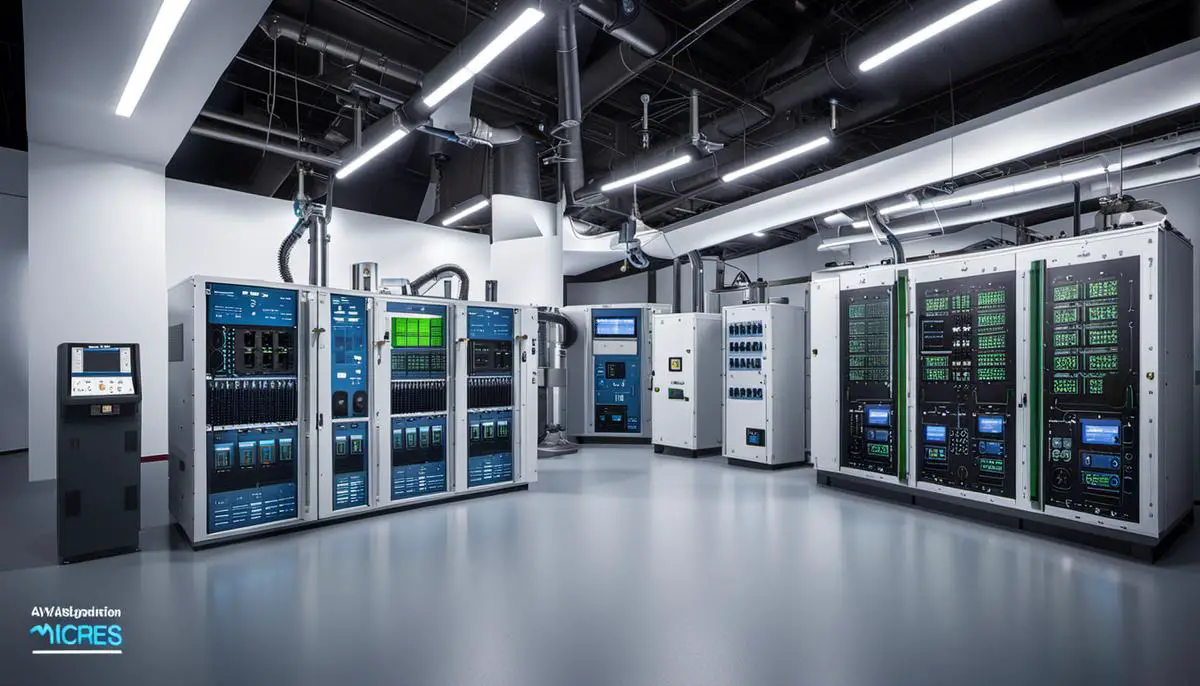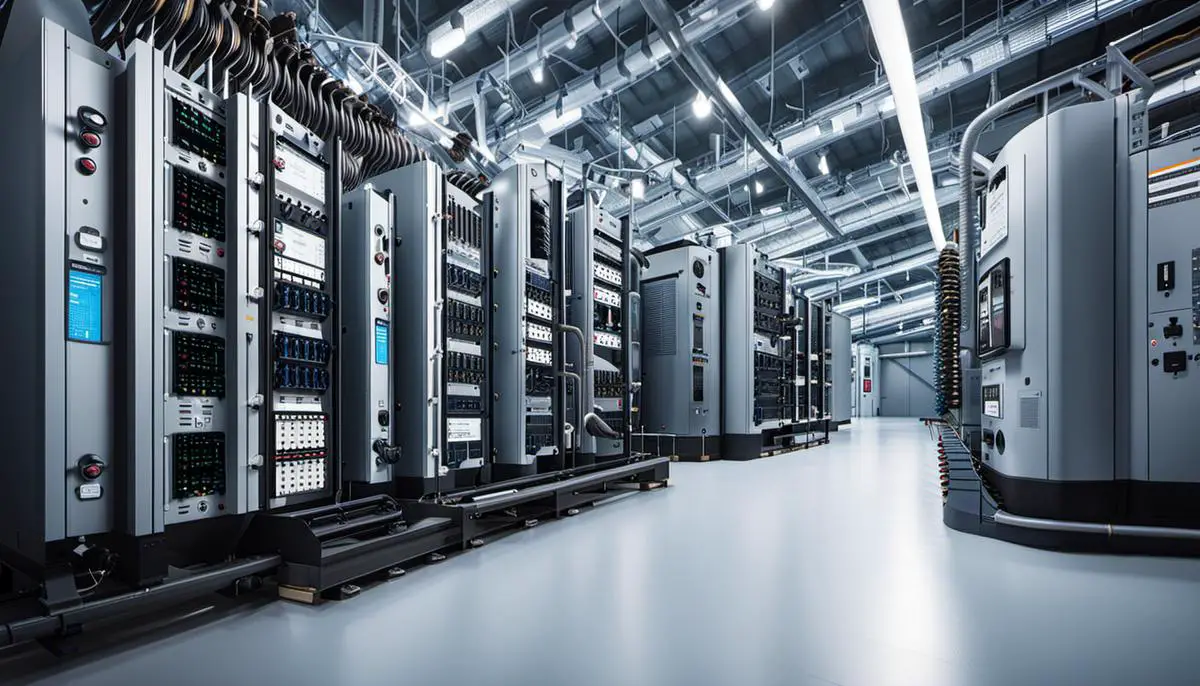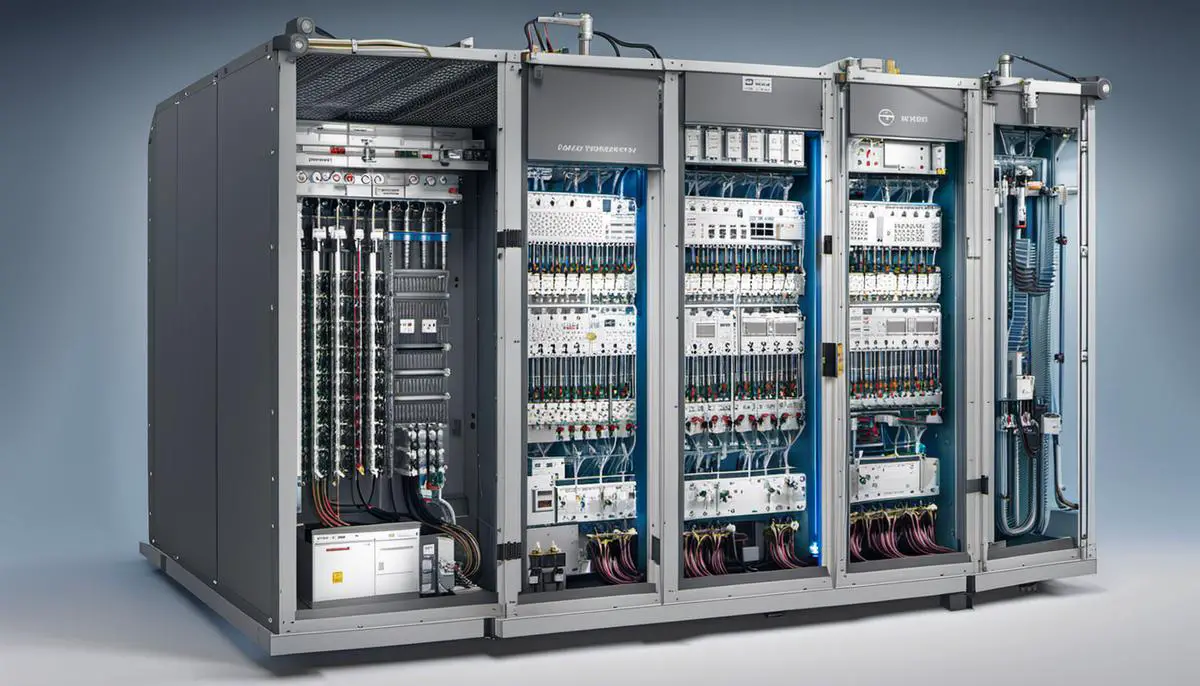
Aiding this process is the Internet of Things (IoT), providing a networked infrastructure that opens new avenues for control and automation. However, despite the host of advantages these technological advancements promise, they also pose fresh challenges in areas like cybersecurity, data management, and skill development. Through real-world case studies, the transformation and progress made in this field can be better understood.
Expanding Horizons: The Future Trends in Substation Automation: As the world continues to digitally evolve, one critical infrastructure undergoing significant transformation is the electrical substation. The advent of digital substations signals a major shift from traditional structures, promising several benefits in terms of efficiency, cost, and monitoring. Moreover, the emergence of advanced technologies like Artificial Intelligence (AI) and Machine Learning (ML) is set to further revolutionize substation operations and management.
Enhancing Efficiency and Safety: The Power of HMI Software
Expanding Horizons: The Future Trends in Substation Automation.
Rise of Digital substations
Understanding Digital Substations
Digital substations are innovative solutions integrated with advanced communication technology that aim to change the traditional methods of energy transmission and distribution. Predominantly, they convert analog data into a digital format for more precise, efficient use, and management of power data. Utilizing state-of-the-art software programs, digital substations are equipped with advanced monitoring systems for real-time decision-making and quicker response to system irregularities.
Understanding Substation Automation & IoT Concepts: A Complete guide for beginner
The Importance of Digital Substations for the Future
Considering the increasing demand for energy and the rise of renewable power sources, digital substations are becoming increasingly essential. They support the integration of renewable energy sources into the power grid, owing to their flexibility and adaptability. Additionally, the market trends of grid modernization and automation drive the need for digital substations. They are designed to handle vast amounts of data, increased power demand, and the integration of distributed energy resources.
Benefits of Digital Substations
Digital substations, compared to traditional ones, have numerous benefits. They offer substantial improvements in reliability, efficiency, and safety. They reduce the necessity for extensive physical infrastructure and also decrease the space needed for installation, contributing to cost-effectiveness. Moreover, by converting analog data to digital format at the earliest point, they improve the quality of data, leading to more precise decision-making. Furthermore, digital substations facilitate remote operation and monitoring, providing more flexibility and enhancing system responsiveness.
Current and Planned Implementations of Digital Substations
An example of current implementation of a digital substation is the upgrade of the Gartenfeld substation in Berlin. The project started by German utility Stromnetz Berlin GmbH in collaboration with Siemens, aims to modernize the existing substation into a fully digital one, contributing to the future vision of a “Smart City Berlin”.
Planned implementations of digital substations are seen worldwide as utilities make strides towards grid modernization. For instance, in the USA, utilities proceed with their plans to integrate digital substations, supported by government initiatives geared towards enhancing grid reliability and efficiency.
A Bright Future for Digital Substations
The future of substation automation trends centers around digital substations. Such innovations are bringing a wealth of promising possibilities to the power grid industry, powered by their myriad of benefits. Alongside an increasing demand for reliable and efficient power networks, these attributes make digital substations an unquestionably prominent element in future power grid systems.
What is Remote Terminal Unit? A Basic Guide
Artificial Intelligence and Machine Learning in Substation Automation
The Impact of Artificial Intelligence and Machine Learning
The advent of artificial intelligence (AI) and machine learning (ML) marks an exciting chapter in various sectors, notably the energy industry. These advanced technologies hold enormous potential to boost efficiency and reliability in substation operations.
All along the electrical energy supply chain, substations play a pivotal role, in converting high-voltage electricity into suitable levels for domestic and industrial consumption. Substation automation has seen significant progress over time, yet the incorporation of AI and ML technologies is set to truly transform how substations function in the future.
Potential Uses of AI and ML in Managing Substations
AI and ML can be employed in numerous ways to manage substation operations. For instance, they can assist with load forecasting by analyzing past consumption trends and predicting future patterns. This can help optimize the allocation of resources and minimize waste.
Besides, AI and ML algorithms can be used to detect and analyze anomalies in operational data, leading to the early identification and diagnosis of equipment faults. This ability facilitates prompt maintenance and prevents costly downtime.
Moreover, these algorithms can be used to manage and control substation devices in real time, further automating operational processes and reducing the reliance on human operators.
Overcurrent Protection in Power Substation
Expected Improvements in Operational Efficiency and Reliability
The integration of AI and ML in substation automation can result in significant improvements in operational efficiency and reliability.
By providing accurate forecasts and real-time monitoring, these technologies can help optimize resource allocation, reducing energy waste, and saving costs. Furthermore, they can enhance operational reliability by enabling the early detection and rectification of issues, minimizing downtime and service interruptions.
For instance, ML algorithms can learn from past data to predict the likelihood of equipment failure, allowing for preventative maintenance, which can significantly extend equipment lifespan and lower maintenance costs.
Challenges and Solutions for Integration
Despite the substantial benefits of integrating AI and ML into substation automation, several challenges need to be addressed. One significant challenge is the requirement of vast amounts of data for training AI and ML models.
Another challenge is dealing with the complexity of AI and ML algorithms and ensuring they are accurately interpreting and responding to data. However, continual improvements in AI and ML techniques, coupled with advancements in data acquisition and processing, are alleviating these challenges.
To overcome these obstacles, close collaboration is needed among AI and ML developers, power system engineers, and data scientists. By working together, these groups can ensure that the AI and ML tools developed are well-suited to the specific requirements of substation operations and can be efficiently integrated.
Moreover, the development of standardized protocols and frameworks can also help streamline the integration process and ensure the interoperability of systems.
Exploring the Future of Substation Automation
With ongoing technological advancements, there is a noticeable trend of integrating Artificial Intelligence (AI) and Machine Learning (ML) into substation automation. The adoption of these revolutionary technologies holds the potential to significantly enhance operational efficiency and reliability in power networks, marking an era of state-of-the-art smart grid technology.
Advent of the Internet of Things (IoT) and its Impact
Interplay between the Internet of Things (IoT) and Substation Automation
The Internet of Things (IoT) is establishing a solid footprint across various industries, with substation automation being one of the prominent areas. Essentially, IoT involves connecting physical devices embedded with electronics, software, sensors, actuators and networking abilities. This connection facilitates communication and data exchange amongst these devices, driving improvements in efficiency and capabilities.
Applications of IoT in Substation Automation
With IoT, substations can perform tasks more efficiently and with less human intervention. IoT devices and sensors are used to gather vital data, including current, voltage, and temperature readings, among other parameters. These parameters are then transferred to data centers for analysis, leading to a swifter and more accurate decision-making process.
In substations, IoT allows for digital communication between various tools, creating an integrated system that optimizes performance and reduces downtimes. This also streamlines the management of different devices centrally, leading to better efficiency in operations and maintenance activities.
Improved Substation Monitoring and Control
One of the most notable benefits of IoT in substation automation is enhanced monitoring and control. The sensors connected in the IoT network gather real-time data, which is crucial for effective fault detection and isolation. More so, IoT’s predictive analytics feature allows for anticipatory maintenance, which helps curb potential faults before they escalate into complex issues.
Moreover, IoT technology enables remote control of substations. This means that substations can be monitored and adjustments made from a central location, eliminating the need for engineers to be physically present at the substation. This not only cuts operating costs but also saves time and improves productivity.
Security and Data Management
While the intersection of IoT and substation automation offers numerous advantages, it also brings about specific challenges, predominantly in the areas of security and data management. Given that substations are critical infrastructures, they can be attractive targets for cyber-attacks.
As such, stringent security protocols must be in place to safeguard the substation and the data it generates. Implementing advanced security measures, such as encryption and two-factor authentication, can help keep data secure.
Also, the vast amount of data the IoT network generates needs effective management. Big Data technologies prove useful in deciphering this data into useful insights, leading to improved decisions, predictions, and greater efficiency in operations.
Substation Automation and the Internet of Things
The rise of the Internet of Things (IoT) indicates a major milestone in substation automation. It improves operations, offers more precise control, enhances monitoring capabilities, and boosts overall productivity. Therefore, the key to unlocking the full potential of this technology in substation automation lies in achieving the right degree of adoption, coupled with the implementation of appropriate security measures.

Benefits and Challenges of Substation Automation
The Gains of Substation Automation
One primary benefit of substation automation lies in operational efficiency enhancement. This improvement is made possible through intelligent electronic devices (IEDs), which are capable of handling and directing operations more precisely and swiftly than humans can. By default, these devices also decrease the risk of faults in the energy system, often resulting from human errors.
Another advantage is the reduction in operational expenses. The automated nature of these substations cuts the need for manual maintenance and inspections, resulting in significant savings on staffing costs and related expenditures in the long run. Moreover, the potential downtime caused by manual checks becomes a thing of the past, contributing to a boost in productivity.
Another boon offered by automated substations is their enhanced fault detection capabilities. By utilizing sophisticated monitoring systems, operators can spot potential issues and address them before they snowball into dire situations. This forward-thinking maintenance approach consequently enhances the lifespan and reliability of the substation.
Challenges of Substation Automation
With these benefits also come substantial challenges. Top among them is cybersecurity. As substations become more automated and interconnected, they also become vulnerable to cyber threats. The critical nature of power infrastructure makes them a high-value target for hostile entities, necessitating robust security measures.
The cost of implementing substation automation is another significant challenge. The upfront investment needed for advanced IEDs, communication equipment, and infrastructural upgrades can be prohibitive for many firms. Additionally, maintaining these systems adds to the ongoing expenses, requiring a reevaluation of return on investment strategies.
Meanwhile, the human skill development required for operating and maintaining automated substations is non-trivial. Workforces need to be retrained to understand and manage the complex technological platforms that drive automation. This necessity for training can further slow adoption, especially among smaller firms with limited resources.
Lastly, interoperability can be a challenge for an automated substation. As substations are often equipped with devices from different vendors, ensuring these systems communicate effectively and securely is not a simple task. Steps need to be taken to ensure that international standards are met or that industry-specific protocols are developed and adhered to.
The Prospective Landscape of Substation Automation
Envisioning the future trajectory of substation automation, it is evident that the path is gradually unfolding toward addressing current challenges while harnessing and streamlining the benefits. A key pivot in this ever-evolving landscape is cybersecurity, a field that is poised to see considerable investment in the way of bolstering protective measures and strengthening system design. As these technologies mature, costs may potentially decline, fostering additional investments in research and development. Despite being marked by a blend of rigorous challenges and promising opportunities, the future outlook of substation automation appears undeniably optimistic.

Case Studies of Substation Automation
A Success Story: Pacific Gas and Electric Company
One notable illustration of successful substation automation implementation comes from the Pacific Gas and Electric Company (PG&E). Striving to elevate their service reliability, mitigate downtime, and boost overall operational efficacy, this large California-based utility company embarked on an automation journey. By deploying Intelligent Electronic Devices (IEDs) and incorporating state-of-the-art communication and data analytics tools, PG&E gained the capability to monitor, manage, and optimize their substations’ performance in real-time. The impact was substantial, with an appreciable drop in outage instances, enhanced service dependability, and a significant improvement in their capacity to detect and resolve issues promptly, leading to rapid restoration of operations.
Case Study: Duke Energy Corporation
Duke Energy Corporation embarked on a forward-thinking endeavor to revolutionize its electricity transmission and distribution system across six states in the U.S. Utilizing state-of-the-art technology, they set out to automate their substations and implement a self-healing grid system. This meant that when a fault or an outage occurred, the system could isolate the affected area and automatically reroute power from other sources, thereby minimizing the impact on customers. The significant decrease in outage minutes per year and improved customer satisfaction showcased the effectiveness of implementing automation in substations.
Case Study: Electricité de France
Even companies outside the U.S. have seen the benefits of substation automation. Electricité de France (EDF), the largest electricity producer and supplier in the world, decided to automate their substations to enhance their asset management capabilities and to improve the reliability and safety of their network. EDF installed an array of sensors and communications devices in their substations that collected vast amounts of data. Through the application of advanced analytics, this data was transformed into actionable insights that promoted proactive maintenance, improved planning, and essentially reduced operational and maintenance costs.
Future Trends in Substation Automation
With the success of these and many other cases, the future of substation automation appears promising. It is expected that more utilities will move towards adopting these smart, digital technologies. Companies are anticipated to closely integrate their substation automation systems with other technologies like the Internet of Things (IoT), artificial intelligence (AI), machine learning (ML), and blockchain. These integrations can offer unprecedented levels of network visibility, prediction, and control, leading to further efficiency, reliability, and safety improvements.
Moreover, as renewable energy sources continue to gain prominence, substation automation will play a crucial role in the smooth integration of these resources into the grid. For instance, incorporate battery storage systems with automation technology would enable better load balancing and energy management.
Lastly, cybersecurity will become an increasingly important concern for substation automation. As substations become more digital and interconnected, they also become vulnerable to cyber threats. As a result, utilities will have to take proactive measures to safeguard their automated systems against increasingly sophisticated cyber-attacks.

Exploring the future of substation automation, we have seen the incredible potential technologies like AI, ML, and IoT hold in pushing the boundaries of efficiency, reliability, and control. We have discussed the major role digital substations are set to play, offering great value over their traditional counterparts. Yet, alongside these promising opportunities lie formidable challenges that must be addressed to unlock their full potential. The transition to greater automation presents issues spanning from cybersecurity threats to high implementation costs and a need for human skill upgradation. By analyzing practical case studies, we gain valuable insights into real-world applications, the success rate, and the lessons learned, aiding us as we move forward in this rapidly evolving landscape.
